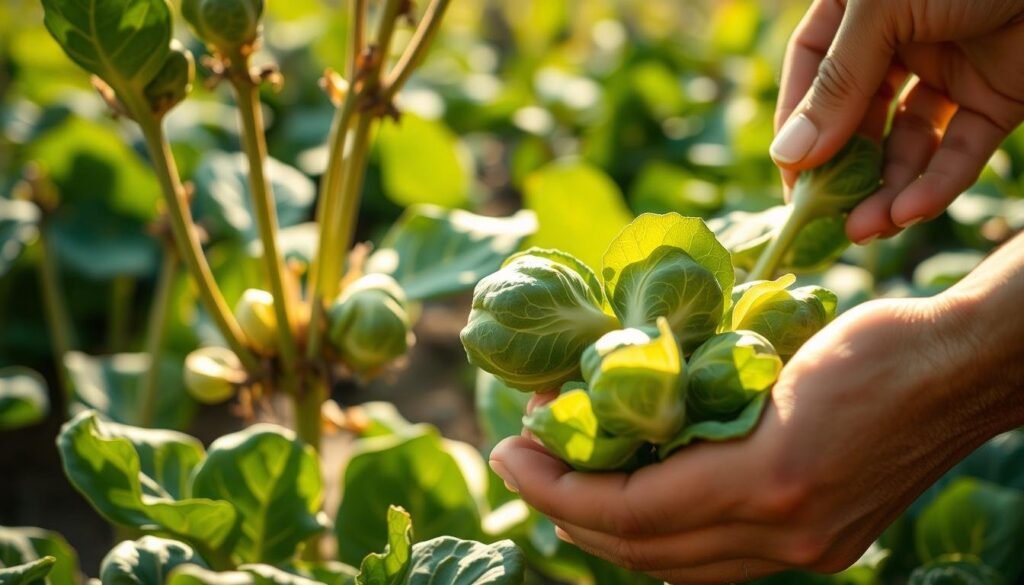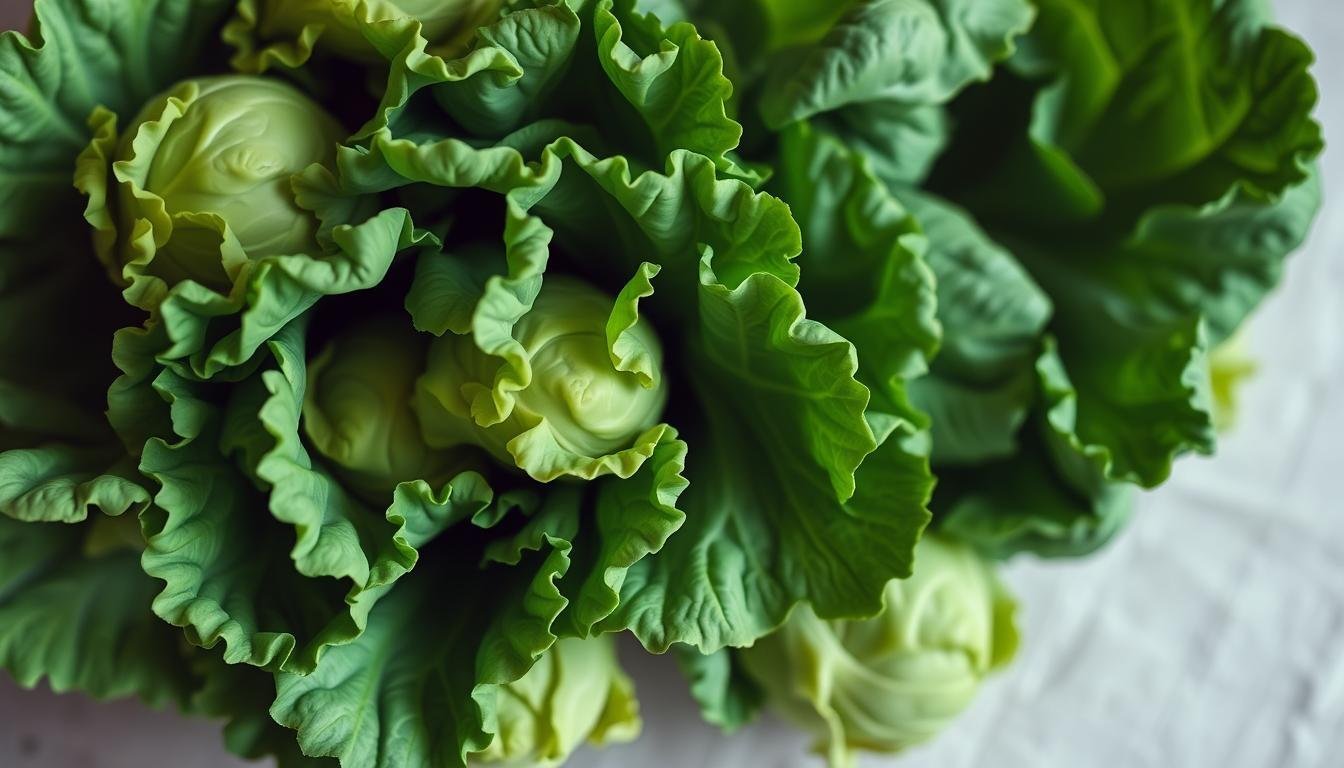Eat the Leaves of Brussels Sprouts: Brussels sprouts are a favorite veggie, especially during the holidays. Many people toss the leaves, but are they safe to eat?
Eating Brussels sprouts leaves can add nutrition and flavor to your meals. They’re packed with vitamins and antioxidants. This makes them perfect for salads, sautés, and more.
Curious about the safety and benefits of Brussels sprouts leaves? This article will give you the facts. You’ll learn how to safely add Brussels sprouts leaves to your diet.
Contents
- 1 Understanding Brussels Sprouts and Their Leaves
- 2 Can You Eat the Leaves of Brussels Sprouts?
- 3 Nutritional Benefits of Brussels Sprout Leaves
- 4 Harvesting Brussels Sprout Leaves
- 5 Preparing Brussels Sprout Leaves for Cooking
- 6 Delicious Ways to Cook Brussels Sprout Leaves
- 7 Conclusion: Eat the Leaves of Brussels Sprouts
- 8 FAQ
- 8.1 Are Brussels sprouts leaves safe to eat?
- 8.2 How do I clean Brussels sprouts leaves before cooking?
- 8.3 Can I eat Brussels sprouts leaves raw?
- 8.4 How do I store Brussels sprouts leaves to keep them fresh?
- 8.5 Can I freeze Brussels sprouts leaves?
- 8.6 What are some ways to cook Brussels sprouts leaves?
- 8.7 Are Brussels sprouts leaves nutritious?
- 8.8 Can I grow my own Brussels sprouts to harvest the leaves?
Understanding Brussels Sprouts and Their Leaves
The leaves of Brussels sprouts are packed with nutrients and can be used in many dishes. These sprouts grow in the cool seasons and are part of the Brassicaceae family. This family also includes cabbage, broccoli, and cauliflower.
Brussels sprouts leaves are rich in vitamins and minerals. They have vitamin C, vitamin K, and folate. They also have phytochemicals that are good for your health.
| Nutrient | Value per 100g |
|---|---|
| Vitamin C | 85 mg |
| Vitamin K | 177 mcg |
| Folate | 175 mcg |
You can use Brussels sprouts leaves in many ways. Try sautéing, steaming, or adding them to soups and salads. Knowing how to use these leaves can make your meals more nutritious and tasty.
Can You Eat the Leaves of Brussels Sprouts?
Many people wonder if they can eat Brussels sprouts leaves. It’s a common question about using the whole plant, not just the sprouts.
Yes, you can eat Brussels sprouts leaves. They belong to the Brassica family. This family includes kale and cabbage, known for their health benefits and taste.
Eating Brussels sprouts leaves adds nutrition to your diet. They have vitamins and minerals like the sprouts. But, their taste and texture might be a bit different. You can sauté or steam them like other leafy greens.
Make sure the leaves are clean before eating them. This means they should be free of pesticides or harmful substances. Also, older leaves might be tougher and taste slightly bitter. So, choose younger leaves for a milder flavor.
Using Brussels sprouts leaves in your meals is good for the environment. It also opens up new ways to cook. You can add them to salads, soups, or enjoy them as a healthy side dish.
Nutritional Benefits of Brussels Sprout Leaves
Brussels sprouts leaves are a nutritional powerhouse. They are not only edible but also packed with vitamins, minerals, and antioxidants. These nutrients can greatly improve your health.
These leaves are rich in vitamins C and K. They also have folate, vitamin B6, and fiber. These nutrients are key for healthy skin, a strong immune system, and good digestion.
The antioxidants in Brussels sprouts leaves protect your cells from damage. This can lower the risk of heart disease, diabetes, and some cancers.
Nutritional Breakdown
| Nutrient | Amount per 100g | % Daily Value |
|---|---|---|
| Vitamin C | 85 mg | 100% |
| Vitamin K | 177 mcg | 150% |
| Folate | 175 mcg | 44% |
Adding Brussels sprouts leaves to your diet is easy and beneficial. You can sauté them, add them to soups, or blend them into smoothies. This way, you get to enjoy their nutritional benefits.
Eating a variety of leafy greens like Brussels sprouts leaves can be a delicious way to support your overall health and well-being.
Harvesting Brussels Sprout Leaves
Harvesting Brussels sprout leaves is rewarding, especially if you grow them yourself. It’s easy to do, whether picking from your garden or buying at a market.
The leaves are ready to pick before the sprouts mature. Start by picking the lower leaves, which are the oldest and largest. This gives you fresh leaves for cooking and helps the sprouts grow.

When buying Brussels sprouts, look for fresh, healthy leaves. Avoid wilted, yellowed, or damaged leaves. Fresh leaves taste better and are more nutritious.
Tips for Harvesting
- Pick leaves regularly to encourage the plant to produce more.
- Use scissors or pinch off leaves to avoid damaging the plant.
- Harvest in the morning for the best flavor.
| Harvesting Method | Description | Benefits |
|---|---|---|
| Picking Lower Leaves | Remove the lower, older leaves first. | Promotes sprout growth, provides edible leaves. |
| Using Scissors | Cut leaves with scissors to avoid plant damage. | Clean, precise harvest. |
| Morning Harvest | Harvest leaves in the morning. | Best flavor, highest nutritional value. |
By following these tips, you can enjoy fresh, nutritious Brussels sprout leaves. Whether you’re a gardener or a food lover, picking leaves is a simple way to improve your meals.
Preparing Brussels Sprout Leaves for Cooking
To get the most from Brussels sprouts, learning to prepare their leaves is key. It’s a few simple steps that can make your dishes better.
First, clean the leaves well. Rinse them under cold water to get rid of dirt. Shake off extra water to keep the leaves crisp.
Then, trim off any damaged or wilted parts. This makes the leaves look better and ensures you’re using the freshest parts. Use a sharp knife or kitchen shears for this.
After trimming, chop or tear the leaves as needed. Some recipes call for whole leaves, while others prefer them chopped.
When cooking Brussels sprouts leaves, the cooking method matters. Whether sautéing, steaming, or roasting, the prep steps are the same. These steps help you enjoy tasty and healthy Brussels sprouts leaves in your meals.
Properly preparing Brussels sprouts brings out their natural taste and texture. They become a great addition to many dishes.
Delicious Ways to Cook Brussels Sprout Leaves
Brussels sprouts leaves are great for many dishes. You can add them to sautés, salads, and more. They’re easy to use in your meals.
Simple Garlic Sauté
Try sautéing Brussels sprouts leaves with garlic. Just heat some olive oil, add minced garlic, and toss in the leaves. They’ll be tender in no time.
Asian-Inspired Stir Fry
For a tasty Asian dish, stir-fry the leaves with soy sauce, ginger, and protein. It’s a healthy and flavorful meal.
You can also make crispy leaf chips. Bake or fry the leaves until they’re crispy. Season with salt for a tasty snack.
| Cooking Method | Preparation Time | Taste Profile |
|---|---|---|
| Simple Garlic Sauté | 10 minutes | Savory, slightly bitter |
| Asian-Inspired Stir Fry | 15 minutes | Umami, slightly sweet |
| Crispy Leaf Chips | 20 minutes | Crunchy, salty |
Roasted with Root Vegetables
Roasting Brussels sprouts leaves with carrots and potatoes is sweet. It’s perfect with a hearty meal.
Brussels Sprout Leaf Salads
Raw leaves add crunch and bitterness to salads. Mix with your favorite dressings and toppings.
Smoothies and Juices
Blend leaves into smoothies or juice them for a nutritional boost. They’re great with apples and pineapples.
Trying new recipes with Brussels sprouts leaves is fun. It’s a great way to reduce waste and enjoy healthy meals. Start experimenting today!
Conclusion: Eat the Leaves of Brussels Sprouts
You now know that Brussels sprouts leaves are not only safe to eat but also full of nutrients. They are rich in vitamins and minerals and have antioxidant properties. This makes them great for your health.
Adding Brussels sprouts leaves to your meals can make your diet even better. You can pick, prepare, and cook them in many tasty ways. This makes them a great addition to your cooking.
Eating Brussels sprouts leaves can boost your immune system and support your overall health. So, when you’re cooking Brussels sprouts, don’t forget to use the leaves. They add extra nutrition to your meal.
See Also: Eating Strawberry Leaves: What You Need to Know
FAQ
Are Brussels sprouts leaves safe to eat?
Yes, Brussels sprouts leaves are safe to eat. They are a nutritious addition to your diet.
How do I clean Brussels sprouts leaves before cooking?
To clean Brussels sprouts leaves, rinse them under cold water. Gently scrub off dirt or debris. Soaking them in cold water can also loosen dirt.
Can I eat Brussels sprouts leaves raw?
Yes, you can eat Brussels sprouts leaves raw. But cooking them brings out their sweetness and makes nutrients more accessible.
How do I store Brussels sprouts leaves to keep them fresh?
Store Brussels sprouts leaves in a sealed container or plastic bag in the fridge. They stay fresh for up to 3 days.
Can I freeze Brussels sprouts leaves?
Yes, you can freeze Brussels sprouts leaves. Blanch them in boiling water for 30 seconds. Then, shock them in an ice bath before freezing. This preserves their color and nutrients.
What are some ways to cook Brussels sprouts leaves?
You can sauté, stir-fry, roast, or boil Brussels sprouts leaves. They’re great in soups, stews, salads, smoothies, and juices.
Are Brussels sprouts leaves nutritious?
Yes, Brussels sprouts leaves are packed with vitamins A, C, and K. They also have minerals like potassium and iron. Plus, they’re full of antioxidants and fiber.
Can I grow my own Brussels sprouts to harvest the leaves?
Yes, you can grow your own Brussels sprouts. They grow well in cool seasons and need full sun and well-draining soil.

Hello, I am Bellamy George, a certified nutritionist and food safety specialist from Springfield, IL. With a degree in Food Science, I share research-backed insights on edible foods, seeds, and seafood for safe, informed eating.

